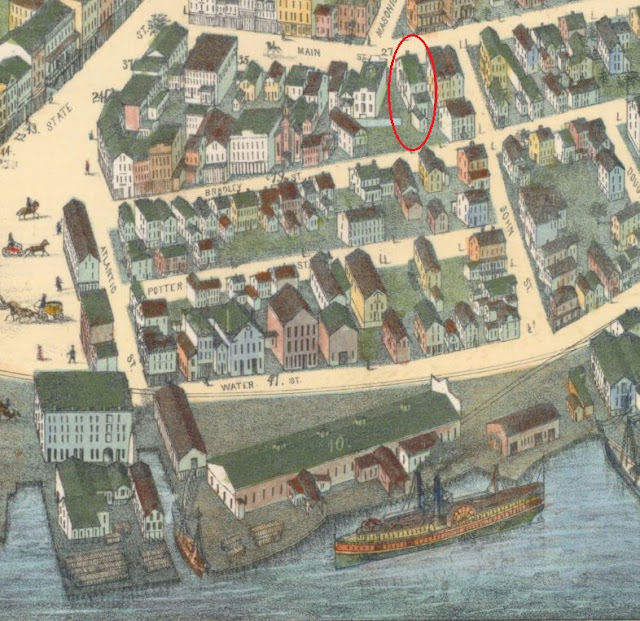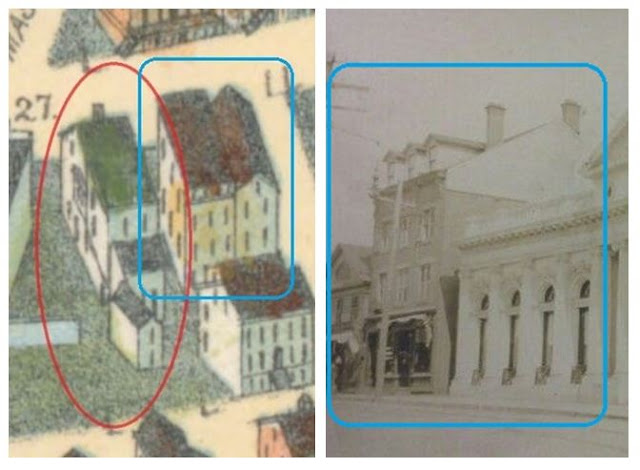Nathaniel Dickinson of New London was a mariner who died at sea in 1797 leaving his estate to his widow, Elisabeth, mother of their 6 small children. My 4th great grandparents, Nathaniel & Elisabeth Bill Dickinson lived in New London, Connecticut in the second half of the 1700’s. In researching the lives of Nathaniel & Elisabeth, I discovered a couple of mentions about their home which led me to try and determine more about their property including specifically where it was located.
The 1797 probate paperwork completed after the death of Capt Nathaniel Dickinson at sea directed that their present New London family home and possessions would be left to his widow, Elisabeth Bill Dickinson after all outstanding bills were settled. The last page of the probate inventory for Nathaniel Dickinson’s estate mentions a "Mansion House & lot with a small Old Shop standing thereon situate on the Main Street north of the Bank". The property was valued at 250 British pounds in the estate.
One might assume that the home was either built or purchased by Nathaniel Dickinson in 1794, however the original loan amount was only slightly more than 10% of the value of the home. Maybe the Dickinson home was built in 1794, but it could also have been built earlier and just used as collateral for the 1794 loan. I wonder why the mortgage was not a bank loan but a loan from an individual; remember that the bank was right next door. Maybe the mortgage note was actually a business loan for Nathaniel and the home was simply used for collateral. In addition to being a seaman himself, Nathaniel also did business putting together crews and supplying ships in New London.
It appears that Elisabeth lived in the Dickinson home for many more years after the death of Nathaniel. I don’t have any record of Elisabeth’s death, however, I do know that the home was listed for rent in 1819, so she could have died prior to that event or possibly moved in with a family member.
When the Dickinson home was advertised “To Let” in 1819, it was described as “The Dwelling House lately occupied by Elizabeth Dickinson, situated on Main street, near New-London Bank, now under repairs …”
According to letters and notes that were
written by Nathaniel & Elisabeth’s son, Capt David Bill Dickinson, he
arranged for his brother-in-law, Benjamin Brown, to manage the property. Benjamin Brown was a well-known businessman
in New London; and David Bill Dickinson resided in Baltimore, Maryland spending
much time at sea as a merchant ship’s captain.
Since both references to the Dickinson home describe that it was located on Main Street and near the New London Bank, I began to try and figure out the specific location in New London, and see if I could learn more about the home. First I looked for an early map of New London, and the earliest that I found online was an 1876 chromolithograph map referred to as a “Bird’s-eye view of New London”. 1876, of course, was more than 50 years after Elisabeth moved out of the home. I wasn’t even sure if the home would still be standing – but it looks to me like it was still there at that time.
This 1876 pictorial map shows drawn detail for many of the buildings and also had a legend numbering system to denote the names and location for some of the significant commercial buildings. The map legend noted seven different banks or financial institutions in New London at the time.
Only one of the banks noted on the map is located on Main Street. This location was near both the center of the city and also only 3 blocks from the dock area. According to the map legend, and noted as building 27, the property on Main Street across from the intersection of Main and Masonic is the Savings Bank of New London. And just to the right of the Bank (which would be north of the Bank as noted in the probate inventory mentioned above) is very possibly the Dickinson home with the small shop in the back.
We know that Nathaniel was
not only a seaman; he also had a shop and business providing goods and services
for the ships that sailed from the area. You can tell from his estate inventory
and settlement that it was an ongoing business. The lot circled above appears
to run from Main Street all the way through to Bradley Street with possibly a
3-story home, an addition, and a small back building that could well be
Nathaniel’s shop. If so, then the
Dickinson home stood for 50+ more years until this map was created after
Elisabeth moved out in 1819.
Today, when looking at Google Maps, I find that several of the New London street names have changed: Main Street is now called Eugene O’Neill Drive, and John Street and Bradley Street are now known as Atlantic Street. But you can see that Masonic Street, State Street and Water Street are all still the same configuration as on the 1876 pictorial map. As expected, the Dickinson family home no longer stands, and has probably been gone for quite some time.
I believe that the property where the Dickinson home was located is very likely now part of the parcel where The Savings Bank of New London now sits at 63 Eugene O’Neill Drive; or the adjacent property at the address of 75 Eugene O’Neill Drive where there is now a modern building.
Next, I tried to find out more on the Savings Bank of New London building. I found information that the Savings Bank building of today was supposedly built in 1852, and expanded with two wings in 1890. And I am guessing the north wing of the Bank now stands on the former Dickinson home property. By 1905, the building was completely enclosed by a new structure designed by the New London architect Dudley Saint Clair Donnelly.
The Savings Bank of New London was
incorporated in 1827. So, it could have
been a different bank at that location prior to 1827, or it is possible that it
was the same bank but just it wasn’t incorporated until 1827. Banks often move into locations where
previous banks were located because the building typically has at least one
large vault or safe.
The Savings Bank of New London failed in 1993 in the wake of a real estate bust when it was shut down by regulators. The bank was then sold to Citizens Financial Group and operated as Citizens Bank for the next 15 years. Citizens sold the building, and in 2019 moved their operation to a new facility. I don’t know if the building is presently occupied, but it is considered a New London landmark building. It is currently listed for almost $3 million and looks quite lovely inside https://www.uspropre.com/property/63-eugene-oneill-drive-new-london-ct-06320/
I found a small booklet that was printed in 1977 on the 150th anniversary of the Savings Bank of New London and it had an early photo of the bank, date unknown but after the two wings were added in 1890.
When I compare this corner of the street to the 1876 map image, it looks to me like the Dickinson home probably came down by the time that the Bank added the wing expansions in 1890. If that is the case, then the two remaining buildings that are on the far left of the old photo would be in the location of the two buildings on the north side of the Dickinson home in the 1876 pictorial map. There is a modern office building presently at that location on the corner just north of the Bank building.
* * * * *
Key Individuals:
Nathaniel
Dickinson (1749 – 1797)
Elisabeth Bill
(~1760 – ~1818)
David Bill Dickinson (1787 – 1846)
Notes:
Several years ago I sent a letter to the New
London City Hall, Land Records Department asking if there might be any deed
information on the old Dickinson home or property. I realize that this was a long shot since it
has been over 200 years, and even the street and address names have
changed. The response indicated that
there “might” be records, that office staff didn’t perform searches, and that I
would need to hire a surveyor or landman to come in and search the old record
files. I tried to contact a person that
they recommended, but he couldn’t do it because COVID had shut down visitors to
the Land Records Department. And after
COVID lifted, that person no longer responded to my emails.
More recently, I sent an inquiry to the company that presently owns the bank property which now includes the adjacent property to the north as well, but still haven’t had any reply from them.
Maybe one day… as I would love to see copies of the original deed for the Dickinson home, if the paperwork still exists. I wish I would have figured this all out when our daughter lived in that neck of the woods, and I could have looked into it then!
– Jane Scribner McCrary

















